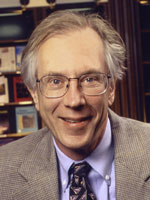 Born in Chicago, Illinois on December 8, 1947, Tom Cech was raised and educated in Iowa (BA in Chemistry from Grinnell College, 1970). He obtained his PhD in Chemistry from the University of California, Berkeley and then engaged in postdoctoral research in the Department of Biology at M. I. T. in Cambridge, Massachusetts. In 1978 he joined the faculty of the University of Colorado, Boulder, where he became a Howard Hughes Medical Institute Investigator in 1988 and Distinguished Professor of Chemistry and Biochemistry in 1990.
Born in Chicago, Illinois on December 8, 1947, Tom Cech was raised and educated in Iowa (BA in Chemistry from Grinnell College, 1970). He obtained his PhD in Chemistry from the University of California, Berkeley and then engaged in postdoctoral research in the Department of Biology at M. I. T. in Cambridge, Massachusetts. In 1978 he joined the faculty of the University of Colorado, Boulder, where he became a Howard Hughes Medical Institute Investigator in 1988 and Distinguished Professor of Chemistry and Biochemistry in 1990.
In 1982 Tom Cech and his research group announced that an RNA molecule from Tetrahymena, a single-celled pond organism, cut and rejoined chemical bonds in the complete absence of proteins. Thus RNA was not restricted to being a passive carrier of genetic information, but could have an active role in cellular metabolism. This discovery of self-splicing RNA provided the first exception to the long-held belief that biological reactions are always catalyzed by proteins. In addition, it has been heralded as providing a new, plausible scenario for the origin of life; because RNA can be both an information-carrying molecule and a catalyst, perhaps the first self-reproducing system consisted of RNA alone. Only years later was it recognized that RNA catalysts, or 'ribozymes', might provide a new class of highly specific pharmaceutical agents, able to cleave and thereby inactivate viral RNAs or other RNAs involved in disease.
Dr. Cech's work has been recognized by many national and international awards and prizes, including the Heineken Prize of the Royal Netherlands Academy of Sciences (1988), the Albert Lasker Basic Medical Research Award (1988), the Nobel Prize in Chemistry (1989), and the National Medal of Science (1995). In 1987 Dr. Cech was elected to the U.S. National Academy of Sciences and also awarded a lifetime Professorship by the American Cancer Society.
In 2000 Dr. Cech moved to Maryland to be president of the Howard Hughes Medical Institute. He continues research on ribozyme structure and on telomerase in his Boulder, Colorado laboratory.